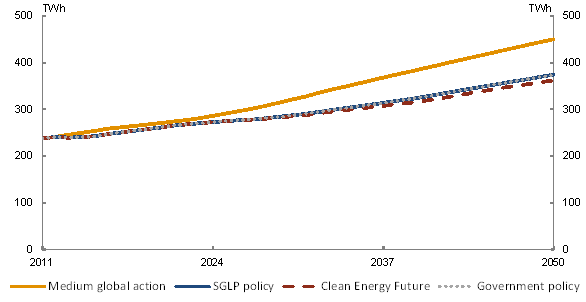Carbon pricing reduces emissions from electricity generation by shifting the generation mix towards cleaner technologies and moderating growth in electricity demand. As in the SGLP scenario, the updated policy scenarios show a transformation in the electricity generation sector towards renewable generation, with gas generation increasing and traditional coal‑fired generation declining. Renewable energy grows from 10 per cent of the generation mix today to 40 per cent by 2050, with around $100 billion in investment in the renewable sector.
The slight differences in electricity generation, emissions and prices between the updated policy scenarios and the SGLP report are due to different starting carbon prices and differences in demand.
Chart 2: Electricity generation

Note: Data are TWh of electricity sent out.
Source: Treasury estimates from MMRF, SKM MMA and ROAM.
In the near term, electricity sector emissions in the updated policy scenarios are slightly lower than in the SGLP policy scenario (cumulatively, around 3 Mt CO2‑e lower to 2014‑15), reflecting the higher starting carbon price.
The SGLP household sector modelling used to calculate the Government’s assistance to households in the Clean Energy Future package showed that, with a carbon price starting at $23/t CO2‑e, overall consumer prices increase by 0.7 per cent in 2012‑13, including an increase in household electricity prices of 10 per cent. There is no need to update that modelling. However, the new electricity sector modelling reaffirms the effect on electricity prices presented in the SGLP report.
In the medium term, after the fixed price period ends, the carbon price moves to the same world price as in the SGLP policy scenario and electricity demand in the updated scenarios is very similar to the SGLP policy scenario. However, from the late 2020s, electricity demand grows slightly more slowly in the Clean Energy Future scenario, compared with the other policy scenarios, due to less electric vehicle take‑up. This slightly lowers electricity sector emissions in the Clean Energy Future scenario compared with the Government policy scenario, although higher fuel combustion emissions in transport more than offset this.
This difference in electricity demand also slows growth marginally in electricity prices in the Clean Energy Future scenario compared with the other policy scenarios. This divergence is small and long‑term electricity prices converge again across the scenarios to reflect the cost of new generation capacity.
Table 5: Average household electricity price increases
Change from medium global action scenario (per cent)

Source: Average of SKM MMA and ROAM.